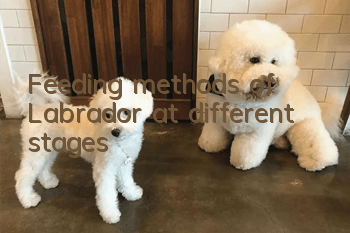Feeding methods of Labrador at different stages

Labradors of different ages have different feeding methods, so parents must pay attention.
Stud dog
First, reasonable and balanced nutrition. Reasonable and balanced nutrition is an important guarantee for ensuring the physical health of dogs and the basis for healthy survival. Therefore, it is necessary to provide dogs with a complete diet to enhance the breeding ability of male dogs.
The second is appropriate and reasonable exercise. Exercise is an important part of strengthening the dog's body metabolism and exercising the nervous system and muscles. Reasonable exercise can promote appetite, help digestion, enhance physical fitness, and improve reproductive function. On the contrary, if the amount of exercise is insufficient, it will seriously affect the breeding utilization of the dog. Breeding utilization is the purpose of raising a breeding male dog, and it is also the main basis for determining its nutrition and exercise amount. For the reasonable breeding and utilization of male dogs, the main considerations should be the age of first breeding and the intensity of use, that is, the frequency of breeding. Generally speaking, the first breeding age of male dogs should be between 17 and 19 months of age, and the frequency of breeding should be one female dog per week.
Breastfeeding female dog
Pregnant female dogs do not need to be fed special feed during the first period of pregnancy (within about 35 days), but they should pay attention to feeding on time. One month later, the fetus begins to develop rapidly, and its requirements for various nutrients increase sharply. At this time, in addition to increasing the food requirements, the pregnant bitch should also be given some digestive and protein supplements. Feeds with high quality content and rich in calcium, phosphorus and vitamins, such as meat, offal, eggs, milk, etc. During the 35th to 45th day of pregnancy, the baby should be fed 4 times a day; do not feed cold feed and drinking water to avoid irritating the gastrointestinal tract, affecting digestion, and even causing miscarriage.
Pregnant female dogs should exercise appropriately. In the early stages of pregnancy (about 1 month of pregnancy), they should exercise for about 2 hours a day. In the later period, free exercise can be used. Pay attention to guarding against heat, and it is strictly forbidden to spank or force them to cross or climb obstacles. In order to prevent mutual squeezing and biting, pregnant female dogs should be raised in double pens, and attention should be paid to maintaining dog body and environmental hygiene.
Puppies before weaning
Never take a bath or go out for a walk before your puppy is fully vaccinated and dewormed. Because puppies at this period (especially those who are just one month old) are in very poor physical condition and have almost no immunity to the outside world. Any oversight may cause them to get sick and die. If the smell is really unacceptable, you can wipe it properly with a warm towel (not recommended), but you must pay attention to keeping warm after wiping. At this period, the puppy should eat at least 4 meals a day. Because his digestion ability is not good enough, he should eat small meals frequently, so don't be afraid of trouble. After 3 months, it can be reduced to 3 meals a day, and after 6 months, it can be reduced to 2 meals a day. From now on, try to maintain 2 meals a day. One meal a day is not recommended. Lala is a very active dog breed. Once it is ready to go out, it is recommended that children under 6 months old should exercise outdoors for at least half an hour a day (excessive exercise is not good for bone growth), and those over 6 months old should exercise outdoors for at least one hour a day. Within 10 months, focus on growing bones. After 10 months, focus on growing meat. Don’tGaining weight too early in order to reach the so-called target weight.
Puppies after weaning
The feeding and management of puppies after weaning is extremely important. The raising stage from weaning to 6 months of age is the key to cultivating a good dog. The most difficult time to raise and manage puppies is one month after weaning. During this period, there are many diseases and high mortality, mainly due to improper feeding and management, which reduces the growth, development and disease resistance of puppies. Puppies after weaning should have protein in their food. Avoid overeating when feeding. It is better to eat less and more meals. Puppies aged 2-3 months should be fed 4-5 times a day and only require 80% of their food each time. Keep an eye on the puppies when they are eating, so that the weak dogs do not get the food and the strong ones eat too much. For dogs over 4-6 months old, in addition to being fed 2-3 times a day, their canine teeth have grown and they like to chew. Some animals can be given long bones. Female dogs become sexually mature at about 6 months old. In order to prevent early mating, dogs of the same gender, age, and size should be put into the same kennel. During the process of group breeding, attention should be paid to picking out dogs with rough temperaments and loving to grab food and putting them into kennels that they can get along with. A one-year-old dog's body has completed its development and can be fed 1-2 meals a day. When the dog is full, if there is still food left in the food bowl, it means there is too much food. On the contrary, if the dog continues to lick the food bowl with his tongue or looks at the owner, it means that the food given is too little and not enough.
Labrador retrievers begin to age from 7 to 8 years old. First of all, good food must be provided, which should not only be of good quality, rich in protein and fat, but also easy to chew and digest. The food should be soft or semi-liquid, with less crude fiber and other feed that is difficult to digest. Older Labrador dogs generally have poor appetite and reduced digestion due to a loss of sense of smell. Therefore, they should be fed more meals and less, and provide sufficient drinking water. Older Labrador dogs have reduced immunity and are afraid of both cold and heat. Therefore, they must do a good job in keeping warm and preventing heatstroke. You should pay more attention to observing the dog's behavior at ordinary times, and diagnose and treat any abnormalities in time. The temperament of older Labrador dogs will also change. They are no longer as lively and active as before. They like to lie quietly, exercise less, sleep more, and get tired easily. Therefore, when taking elderly dogs for activities, attention should be paid to preventing fatigue. In addition, the coordination of muscles and joints and the control and coordination functions of nerves in older dogs are far inferior to those in prime-age dogs, and their bones also become fragile. Therefore, older dogs cannot be allowed to do complex and difficult movements to prevent muscle strains and fractures.
- What kind of food should dogs eat?
- Teach you four steps to identify good dog food!
- What should you pay attention to when choosing a dog house?
- Oral diseases in dogs and cats are very harmful, teach you how to identify and prevent them!
- What types of dog food are there and how to choose dog food?
- Causes of excessive gum in puppy eyes and how to care for them
- Dog's nose is leaking clear water
- Dog allergy symptoms
- Things you need to pay attention to when grooming your dog in winter
- What are the symptoms of dog poisoning?



